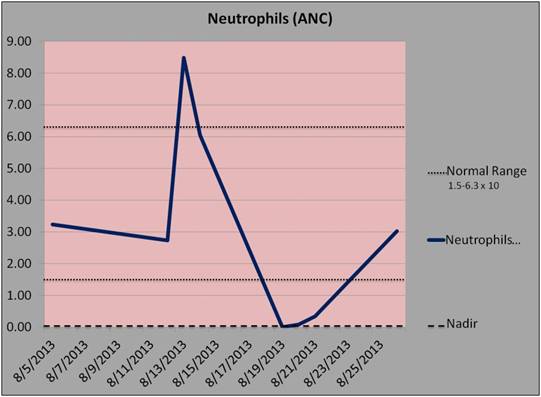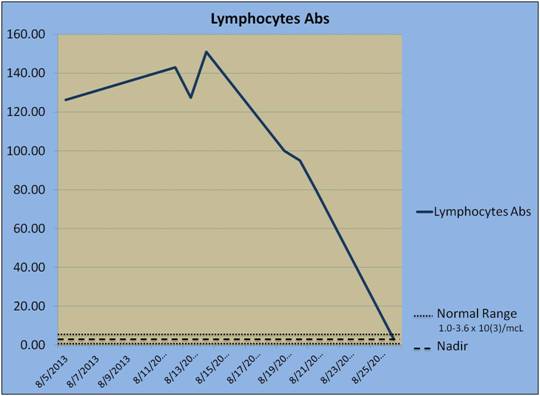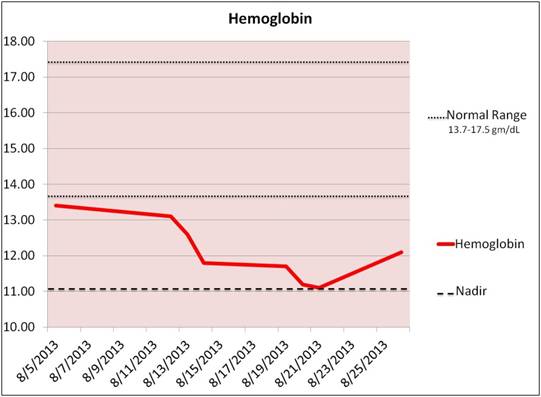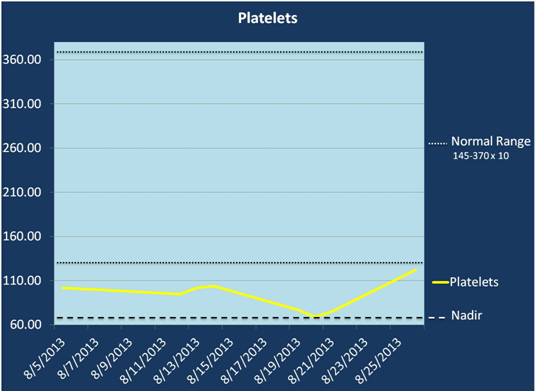Rock me like a wagon wheel... Like tumble weeds, rolling along through the dust and drought.
During my Aug. 26 visit to Dartmouth-Hitchcock Medical Center we discussed my blood counts. From these and other recent counts we were able to create nadir graphs to show how low my different blood counts dropped before they began rising. The drop in counts is due to the chemotherapy doing its job; the rise in counts is required in order for me to continue to receive chemotherapy. Since I was hospitalized the week after chemotherapy, I had multiple blood counts from which to develop graphs to share with you. I thought this part was actually cool, and I even enjoyed creating the graphs and transforming them into pictures -- they gave my chemo brain quite the challenge.
White Blood Cells
Think of your white blood cells (WBC) as your frontier military armed against invasion. The WBCs are composed of different types of cells, each with a designated function in helping you fight off infections. At the time of chemotherapy, my white blood cells numbered 148.9 (148,900) which is extremely high. This count reflected a total of both the Neutrophils at 2.73 (2,730) and Lymphocytes at 143.0 (143,000), both discussed in more detail below, with the remaining WBC components the differential. After chemotherapy my WBCs went to a low, as reflected in the nadir graph below, of 1.8 (1,800); and they have rebounded nicely to 5.9 (5,900) which is within the normal range (4.0-10.0 x 10) -- a sight for sore eyes -- where they have not been for over a decade.

Neutrophils
As you may remember from Part 5, neutrophils are part of the WBCs and play a critical part in fighting infections -- think of them as the cavalry charging to save the day. Without neutrophils in our body, we are susceptible to a multitude of bacterial infections. On the first day of chemotherapy my neutrophils stood at 2.73 (2,730), which is within the acceptable range for receiving chemotherapy. The lowest my neutrophils went after chemotherapy was zero, during which I was running a fever over 100.4 degrees Fahrenheit -- I had sever neutropenic fever. It is considered dangerous for the neutrophils to fall below 1.2 (1,200). As you can see in the nadir graph below, they have rebounded nicely to 3.02 (3,020) which is within the normal range (1.50-6.30 x 10(3)/mcL). Unfortunately they only live about three days -- I'm rooting for you guys!

Lymphocytes
Another component of the WBCs, as referenced above, is the lymphocytes. A simplified explanation of the lymphocytes is that they serve as an indicator of the level of leukemia in the body -- think of them as the advancing enemy (for chronic lymphocytic leukemia [CLL] they are a slowly advancing adversary). Suffice it to say that the count of lymphocytes is watched as their exponential growth crowds out other blood cells, leading to issues such as repeated, prolonged infections and anemia. As such, the higher the count of lymphocytes goes, the worst they are. My count was at 143.0 (143,000) on the first day of chemotherapy. [Please note: This count was not why I began chemotherapy. I don't want people to think that this is a magic number for chemotherapy, as your journey will be different from mine. I began chemotherapy due to the enlarged size of my spleen. ] The hope with chemotherapy is that the number of lymphocytes will return to a "normal" single-digit, which by Aug. 26 -- to 2.4 (2,400) -- which is within the normal range for lymphocytes (1.0-3.6 x 10[3]/mcL). This 2.4 also happens to be the nadir for my lymphocytes (see graph below). Yohoo!

Red Blood Cells
The Red Blood Cells (RBCs) perform two critical parts of keeping us alive: 1) they carry oxygen throughout the body; and 2) they eliminate waste from the blood. Think of the RBCs as the supply wagons providing provisions to the troops and recycling waste. The good news about RBCs is that they live, on average, for 120 days. However, they too suffer from the growth of lymphocytes by being crowded out, dangerously decreasing their number. At the time of chemotherapy, my RBCs were at 4.38 (4,380); their nadir (see graph below) was a low of 3.72 (3,720), and as of Aug. 26 they were on the rise at 4.03 (4,030), not yet back within the normal range (4.63-6.08 x 10) but close -- keep on truckin'...

Hemoglobin
A part of RBCs is the hemoglobin. It is a protein that carries life giving oxygen to your organs -- think of them as the food within the supply wagons to sustain the troops. When the hemoglobin count is low it is termed as anemia. With the expansion of the lymphocytes within the blood, the RBDs, including the hemoglobin, are decreased. If the hemoglobin falls below 10 it is considered serious, while below 8.5 a blood transfusion is required. The first day of my chemotherapy my hemoglobin was at 13.1 (13,100); it reached a nadir (see graph below) of 11.1 (11,100) and has bounced back as of Aug. 26 to 12.1 (12,100). While this is still not in the normal range [13.7-17.5 gm/dL), it is a going in the right direction -- pump it up!

Platelets
Ending with another part of the blood critical to understanding how leukemia impacts the body are the platelets. The simplest explanation for platelets is that they are the cells that cause the blood to clot when we are injured -- think of them as the medics providing healing. They, too, get crowded out by the expansion of the lymphocytes within the blood (ITP treatment considerations). We want them to be over 100 (100,000) while recovering from chemotherapy. The first day of chemotherapy, my platelets were at 95 (95,000); the platelets' nadir (see graph below) was 69 (69,000); and as of 26-Aug they had wonderfully rebounded to 122 (122,000). While this is still not in the normal range (145-370 x 10(3)/mcL), they are rapidly moving in the right direction and are better than what they had been for a long time -- keep on keepin' on...

I hope this has been helpful in adding to your knowledge of how chemotherapy for CLL impacts the blood in which the cancer is traveling.
Since I had asked my oncologist, I thought I'd let you know that during chemotherapy sex is a no-go if the platelets are less than 50 or the neutrophils are less than 1.0. It was explained to me that our system may not be able to handle the exertion of making love. Also, men should wear condoms while undergoing chemotherapy as their sperm will most likely be impacted by the drugs. Good advice all around -- not that you actually feel sexy....
Also during this meeting we discussed my next round of chemotherapy scheduled to begin on Sept. 9. Given the above information, we should be fine to begin on that date. Of course, more blood will be analyzed that morning to ensure we can begin. We also discussed that this will most likely be a full six-month protocol which will take me through January of 2014.
Although my fingers continue tingling, I am feeling much better -- in a relative sense. I have also started gaining some of the weight I lost. While I am no longer confused or disoriented, I do still have chemo brain which means it takes me longer to remember or think of things. I do find myself dizzy if I make a jarring move or stand up too quickly. Also, I am almost always tired and take frequent naps.
Timing: Sept. 9 - Sept. 12: cycle two of chemotherapy
Oh, and Polly Hoffman and John Rist have been added to my list of angels here on earth.
Rock me like a wagon wheel...